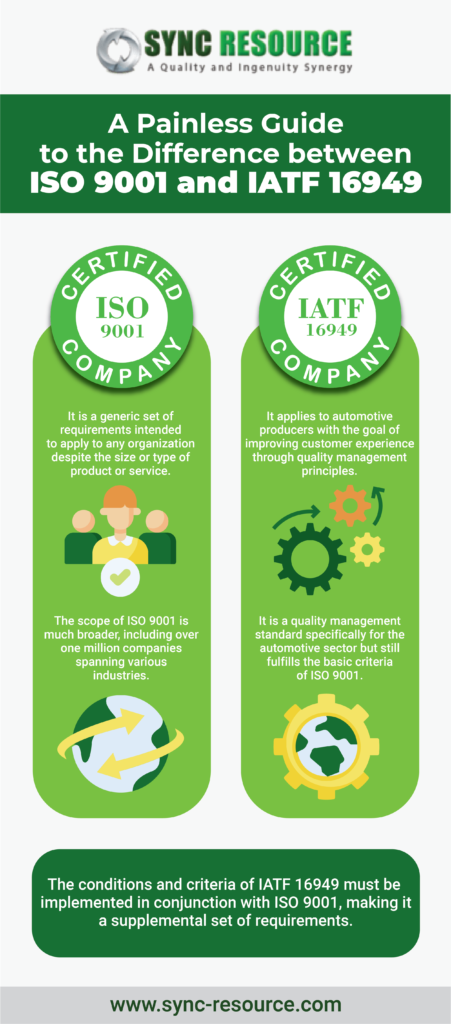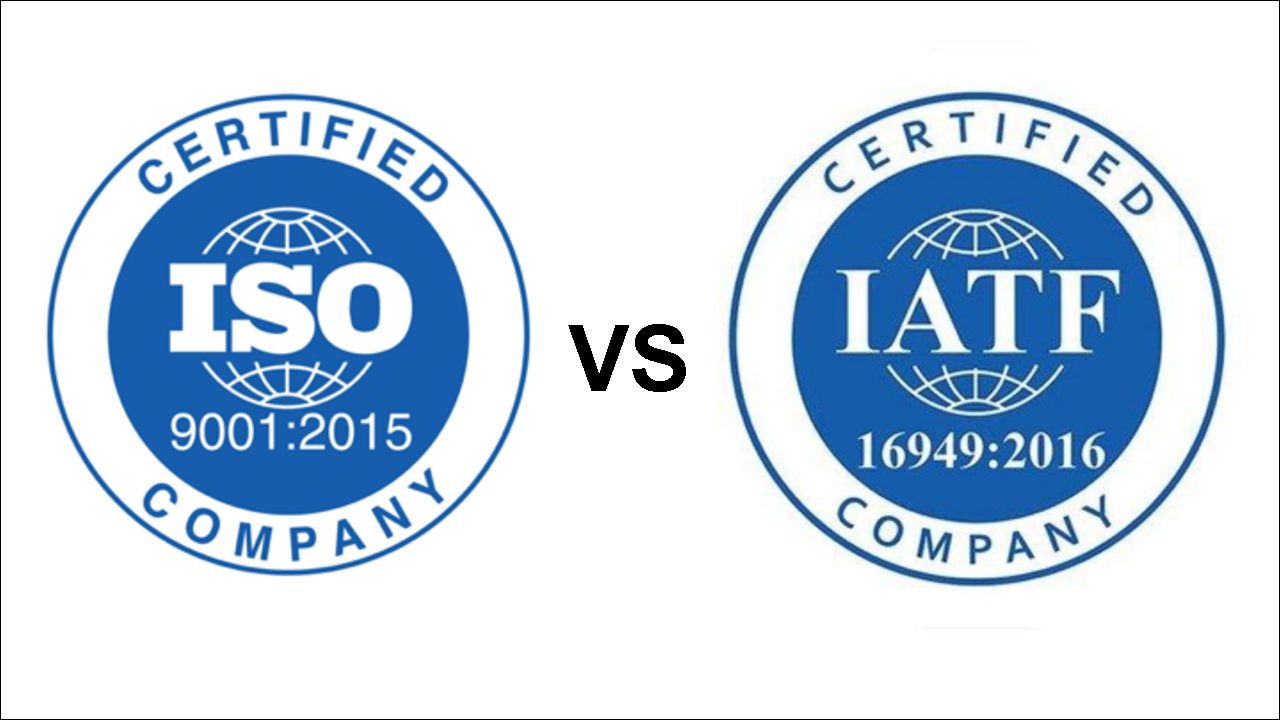To fully understand the difference between ISO 9001 and IATF 16949, let’s begin with the most general observations. IATF 16949 was developed originally by a group of manufacturers to provide better products to automotive consumers.
By contrast, the scope of ISO 9001 is much broader, including over one million companies spanning various industries. Both standards, however, aim to improve the quality of a product with a customer focus. In fact, there are many similarities despite this obvious difference between ISO 9001 and IATF 16949.
To dig a bit deeper into the difference between ISO 9001 and IATF 16949, we want to explore the principles of ISO 9001 and IATF 16494 to truly get at their inherent differences. In what follows, you will learn:
• The basic requirements of ISO 9001 and IATF 16949,
• The key focus areas of both criteria, and
• The most essential distinctions between both standards.
Basic Requirements of ISO 9001 and IATF 16949
While you might think that ISO 9001 and IATF 16494 are exclusive to each other, it turns out considerable overlap is seen within the requirements of their criteria. In many cases, a company held under both guidelines, like a one in the automotive sector, will need to satisfy the requirements of each. It helps that IATF 16949 is based on ISO 9001, but that doesn’t mean there isn’t a considerable difference between ISO 9001 and IARD 16949.
ISO 9001
Because ISO 9001 is a generic set of requirements intended to apply to any organization despite size or type of product, service, or process, it basically requires two things:
1. The organization needs to show it can consistently provide satisfying products and services to customers while meeting regulations.
2. It must also aim to enhance satisfaction through continual processes of improvement while conformity is assured.
These requirements are defined under 8 sections for implementing a satisfactory quality management system. An initial difference between ISO 9001 and IATF 16949 is their specificity. In comparison, the IATF 16494 is more specific with its conditions since it narrows its focus on producers in the automotive industry specifically.
IATF 16949
The IATF 16949 applies to automotive producers with the goal of improving customer experience through quality management principles.
This is an important difference between ISO 9001 and IATF 16949 (which we will touch on later in this article). That is, the requirements of IATF 16949 are supplemental to the ISO 9001 which forms the base requirements for any quality management system. Let’s dig into the scope of IATF 16949 requirements.
The requirements of IATF 16949 focus on these key areas:
• Continual process improvement,
• Effective defect prevention,
• Waste-reducing practices,
• Proven product safety,
• Industry risk management,
• Planning for contingency, and even
• Management of lower-level suppliers.
You’ll see that demonstrating these elements in your own quality management system and practices is much more detailed than the general ISO 9001 conditions.
Key Focus Areas of ISO 9001 and IATF 16949
Since IATF 16494 is based on ISO 9001, you expect there to be considerable similarity in requirements. And, both emphasize the following focus areas: organizational context, leadership, planning, support, operation, evaluation, and improvement.
Organizational Context
Contextualizing your organization’s operations means understanding the needs and expectations of all interested parties.
Leadership
Under leadership, both establish the need for commitment as well as clearly outlined policies, organizational roles, and final authorities.
Planning
The planning section outlines how actions address opportunities as well as risks. There are clear quality objectives and plans to achieve them through systematic changes.
Support
To consider support, both standards place a heavy burden on companies to achieve resources, competence, and awareness. This means training, audits, and even employee empowerment.
Operation
Here we include conditions for products, services, and design and development. This means consideration of operational planning, manufacturing processes, design validation, prototype management, and outputs.
Evaluation
Monitoring, analysis, and measurement are key in the evaluation section of these standards. They demand an internal audit and management review for all products and processes. It’s here that you would identify statistical tools of analysis of customer satisfaction as well.
Improvement
Finally, improvement deals with the issues of nonconformity and the need for corrective action to produce incremental change and advancement. This means error-proofing and dealing with customer feedback and complaints.
Essential Difference between ISO 9001 and IATF 16949
In essence, IATF 16949 is a quality management standard specifically for the automotive sector but still fulfills the basic criteria of ISO 9001. In fact, IATF 16949 was created to synchronize certification worldwide for all automotive supply chains and assessments. Interestingly, however, the IATF is a document that can’t stand without ISO 9001. This primary difference between ISO 9001 and IATF 16949 should be understood.
As we have noted before, the conditions and criteria of IATF 16949 must be implemented in conjunction with ISO 9001, making it a supplemental set of requirements. This signals an important difference between ISO 9001 and IATF 16949 even when both systems have the essential function of improving experiences, products, and processes.
Learn more about ISO 9001 and IATF 16949 Differences
While this introductory comparison is instructive for learning more about the structure, requirements, and goals of these two important sets of criteria, there may be a need to learn more from more experienced quality management professionals about the difference between ISO 9001 and IATF 16949.

Contact Sync Resource today for a consultation on how you can meet quality standards, and see how we can improve your practices to stimulate constant and incremental improvement to satisfaction and services.
[/fusion_text]
[/fusion_builder_column][/fusion_builder_row][/fusion_builder_container]

Recent Comments